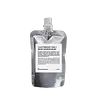What's inside
What's inside
 Key Ingredients
Key Ingredients

 Benefits
Benefits

 Concerns
Concerns

 Ingredients Side-by-side
Ingredients Side-by-side

Water
Skin ConditioningCaprylic/Capric Triglyceride
MaskingGlycerin
HumectantCetearyl Alcohol
EmollientButyrospermum Parkii Butter
Skin ConditioningGlyceryl Stearate
EmollientDiheptyl Succinate
EmollientSimmondsia Chinensis Seed Oil
EmollientPolyglyceryl-6 Palmitate/Succinate
EmulsifyingBenzyl Alcohol
PerfumingTocopheryl Acetate
AntioxidantCapryloyl Glycerin/Sebacic Acid Copolymer
Skin ConditioningXanthan Gum
EmulsifyingBenzoic Acid
MaskingDehydroacetic Acid
PreservativeAloe Barbadensis Leaf Juice Powder
Skin ConditioningSodium Hydroxide
BufferingTocopherol
AntioxidantWater, Caprylic/Capric Triglyceride, Glycerin, Cetearyl Alcohol, Butyrospermum Parkii Butter, Glyceryl Stearate, Diheptyl Succinate, Simmondsia Chinensis Seed Oil, Polyglyceryl-6 Palmitate/Succinate, Benzyl Alcohol, Tocopheryl Acetate, Capryloyl Glycerin/Sebacic Acid Copolymer, Xanthan Gum, Benzoic Acid, Dehydroacetic Acid, Aloe Barbadensis Leaf Juice Powder, Sodium Hydroxide, Tocopherol
1,2-Hexanediol
Skin ConditioningAllantoin
Skin ConditioningWater
Skin ConditioningBifida Ferment Lysate
Skin ConditioningBisabolol
MaskingButylene Glycol
HumectantButyrospermum Parkii Butter
Skin ConditioningCaprylhydroxamic Acid
Cetearyl Alcohol
EmollientCetearyl Glucoside
EmulsifyingChlorphenesin
AntimicrobialCitric Acid
BufferingDicaprylyl Carbonate
EmollientDimethicone
EmollientDisodium EDTA
Glucose
HumectantGlycerin
HumectantGlyceryl Stearate
EmollientHydroxyethyl Acrylate/Sodium Acryloyldimethyl Taurate Copolymer
Emulsion StabilisingMirabilis Jalapa Extract
Skin ConditioningPEG-100 Stearate
PEG-8
HumectantPEG-6 Caprylic/Capric Glycerides
EmulsifyingPhragmites Karka Extract
Skin ConditioningPolysilicone-11
Poria Cocos Extract
Skin ConditioningPropanediol
SolventSaccharide Isomerate
HumectantSodium Benzoate
MaskingSodium Citrate
BufferingSodium Hyaluronate
HumectantSqualane
EmollientTocopheryl Acetate
AntioxidantXanthan Gum
Emulsifying1,2-Hexanediol, Allantoin, Water, Bifida Ferment Lysate, Bisabolol, Butylene Glycol, Butyrospermum Parkii Butter, Caprylhydroxamic Acid, Cetearyl Alcohol, Cetearyl Glucoside, Chlorphenesin, Citric Acid, Dicaprylyl Carbonate, Dimethicone, Disodium EDTA, Glucose, Glycerin, Glyceryl Stearate, Hydroxyethyl Acrylate/Sodium Acryloyldimethyl Taurate Copolymer, Mirabilis Jalapa Extract, PEG-100 Stearate, PEG-8, PEG-6 Caprylic/Capric Glycerides, Phragmites Karka Extract, Polysilicone-11, Poria Cocos Extract, Propanediol, Saccharide Isomerate, Sodium Benzoate, Sodium Citrate, Sodium Hyaluronate, Squalane, Tocopheryl Acetate, Xanthan Gum
 Reviews
Reviews

Ingredients Explained
These ingredients are found in both products.
Ingredients higher up in an ingredient list are typically present in a larger amount.
This ingredient is also known as shea butter. It is an effective skin hydrator and emollient.
Emollients help soothe and soften your skin. It does this by creating a protective film on your skin. This barrier helps trap moisture and keeps your skin hydrated. Emollients may be effective at treating dry or itchy skin.
Shea butter is rich in antioxidants. Antioxidants help fight free-radicals, or molecules that may harm the body. It is also full of fatty acids including stearic acid and linoleic acid. These acids help replenish the skin and keep skin moisturized.
While Shea Butter has an SPF rating of about 3-4, it is not a sunscreen replacement.
Shea butter may not be fungal acne safe. We recommend speaking with a professional if you have any concerns.
Learn more about Butyrospermum Parkii ButterCetearyl alcohol is a mixture of two fatty alcohols: cetyl alcohol and stearyl alcohol. It is mainly used as an emulsifier. Emulsifiers help prevent the separation of oils and products. Due to its composition, it can also be used to thicken a product or help create foam.
Cetearyl alcohol is an emollient. Emollients help soothe and hydrate the skin by trapping moisture.
Studies show Cetearyl alcohol is non-toxic and non-irritating. The FDA allows products labeled "alcohol-free" to have fatty alcohols.
This ingredient is usually derived from plant oils such as palm, vegetable, or coconut oils. There is debate on whether this ingredient will cause acne.
Due to the fatty acid base, this ingredient may not be Malassezia folliculitis safe.
Learn more about Cetearyl AlcoholGlycerin is already naturally found in your skin. It helps moisturize and protect your skin.
A study from 2016 found glycerin to be more effective as a humectant than AHAs and hyaluronic acid.
As a humectant, it helps the skin stay hydrated by pulling moisture to your skin. The low molecular weight of glycerin allows it to pull moisture into the deeper layers of your skin.
Hydrated skin improves your skin barrier; Your skin barrier helps protect against irritants and bacteria.
Glycerin has also been found to have antimicrobial and antiviral properties. Due to these properties, glycerin is often used in wound and burn treatments.
In cosmetics, glycerin is usually derived from plants such as soybean or palm. However, it can also be sourced from animals, such as tallow or animal fat.
This ingredient is organic, colorless, odorless, and non-toxic.
Glycerin is the name for this ingredient in American English. British English uses Glycerol/Glycerine.
Learn more about GlycerinGlyceryl Stearate is a mix of glycerin and stearic acid.
It is used to stabilize the mixing of water and oil ingredients. By preventing these ingredients from separating, it can help elongate shelf life. It can also help thicken the product's texture.
As an emollient, it helps soften skin and supports barrier-replenishing ingredients.
In cosmetics, Glyceryl Stearate is often made from vegetable oils or synthetically produced.
This ingredient may not be fungal-acne safe
Fun fact: The human body also creates Glyceryl Stearate naturally.
Learn more about Glyceryl StearateTocopheryl Acetate is AKA Vitamin E. It is an antioxidant and protects your skin from free radicals. Free radicals damage the skin by breaking down collagen.
One study found using Tocopheryl Acetate with Vitamin C decreased the number of sunburned cells.
Tocopheryl Acetate is commonly found in both skincare and dietary supplements.
Learn more about Tocopheryl AcetateWater. It's the most common cosmetic ingredient of all. You'll usually see it at the top of ingredient lists, meaning that it makes up the largest part of the product.
So why is it so popular? Water most often acts as a solvent - this means that it helps dissolve other ingredients into the formulation.
You'll also recognize water as that liquid we all need to stay alive. If you see this, drink a glass of water. Stay hydrated!
Learn more about WaterXanthan gum is used as a stabilizer and thickener within cosmetic products. It helps give products a sticky, thick feeling - preventing them from being too runny.
On the technical side of things, xanthan gum is a polysaccharide - a combination consisting of multiple sugar molecules bonded together.
Xanthan gum is a pretty common and great ingredient. It is a natural, non-toxic, non-irritating ingredient that is also commonly used in food products.
Learn more about Xanthan Gum